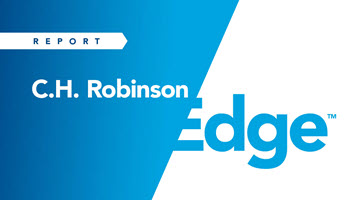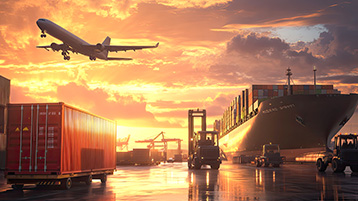
Mat: Welcome to the August edition of the Robinson Edge Video. My name is Mat Leo, and as always, I'm joined by Ryan Hammett to talk about the latest developments in the freight market. Today we will cover the newly released 2026 truckload cost per mile forecast and how ocean performance has been trending.
But first, let's talk about how the U.S. trade policy has reshaped import relationships.
Ryan: In recent years, global trade dynamics have undergone a profound transformation with the United States actively reshaping its import strategy. While this has been most obvious here in 2025, it's been happening since 2017 when some companies began developing China plus one strategies in response to the rounds of tariff and trade investigations that were announced at that time.
Driven by shifting geopolitical priorities and evolving economic policies, this realignment is now redefining how and where American businesses source their goods, and it reflects a deliberate change in trade policy and broader economic strategy. One of the most striking developments has been the sharp decline in imports from China. In 2017, China accounted for approximately 22% of total U.S. imports. However, through the first half of 2025, that figure has dropped dramatically to just 9% of US imports.
And this decline hasn't occurred in isolation. At the same time, other trading partners have gained ground. Mexico, in particular, has emerged as the largest source of U.S. imports by share, now representing 15% of the total. The European Union has also seen steady growth in its share of U.S. imports, indicating a broader diversification of sourcing strategies amongst American companies.
Mat: And this transformation is not merely the result of market dynamics. It's the outcome of intentional policy decisions to reduce dependency on China. The rationale behind this shift includes concerns over national security, the need for more resilient supply chains, and long-standing issues related to unfair trade practices. As a result, we've seen a rise in imports from countries such as Vietnam, Taiwan, and Mexico, as these nations have benefited from companies actively seeking alternatives to Chinese manufacturing.
Ryan: Looking ahead, this realignment will continue. Geopolitical tensions remain high, and discussions around tariffs and trade barriers are ongoing. But the United States is expected to deepen its economic ties with allies and regional partners, reinforcing a more distributed and secure supply chain network while also encouraging manufacturing growth in the U.S.
For businesses, whether they're retailers, manufacturers, or logistics providers, this evolving landscape demands strategic adaptation. The mindset has shifted from tariffs potentially being temporary to now understanding that they are likely permanent. So many businesses are already aligning their operations with the expectation that elevated tariffs and regulatory scrutiny will persist.
While each supply chain is unique, the overarching trend is clear. Diversification away from China is no longer just a contingency plan. It's becoming a core component of long-term strategy. And I think it's also important to note that the administration is making this clear in the tariff rates announced in the new trade deals.
The higher tariffs are focused on China, while the next highest on those countries highly integrated or aligned with China. And as you get closer to the U.S., relationally and geographically, you are seeing lower tariff rates all the way down to 0% for USMCA qualified goods. So it will be important to keep this sourcing hierarchy in mind as you make decisions.
Ryan: And as global trade continues to evolve, one area that's shown notable improvement is ocean freight reliability. Now, let's take a closer look at what's driving this shift and what it means for shippers heading into the second-half of 2025. Ocean carriers have made meaningful strides in schedule consistency. And according to the latest data from June, the global schedule reliability has climbed over 67%, which is actually the highest we've seen since 2023.
Even more encouraging is the average delay for late vessels has continued to drop and now at 4.5 days, marking the best performance in nearly two years. And beyond just the broad global averages, regionally, the momentum is pretty clear. Asia to North America West Coast services has reached 78% reliability, while to the East Coast has rose over 71%.
Even some of the traditionally volatile routes, such as Asia to the Mediterranean, are also showing signs of stability as well. And it's not just outbound Asia that we're seeing the benefits from either. Performance from South America to North America surged by 14 points to over 81%, which leads all trade lanes in month-over-month gains.
Ryan: Mat, I think it's important to note that for shippers, what you just discussed isn't just a retrospective data point. It's a forward-looking signal. With five consecutive months of reliability gains and shrinking delay windows, peak season planning may finally shift from reactive crisis management to proactive strategic execution.
While carriers are still refining schedules and some lane-specific volatility remains, the broader trend suggests that service predictability is becoming a competitive advantage rather than a persistent challenge. But what's driving this improvement?
One major factor is the ongoing diversification of supply chains away from China. In June, container volumes from China dropped 27% year over year. And despite a 33% surge out of Southeast Asia, this resulted in a net decline in total Asia volumes, leading to capacity demand imbalances.
Mat: And these imbalances are also reflected in pricing trends too. The trans-pacific spot rates have continued to slide, particularly on the U.S. to the West Coast corridor, but to the East Coast as well, with that initial rate differential between the two corridors largely diminishing. Carriers did announce rate increases effective August 1st. However, those proposed hikes were ultimately not implemented.
And this is due to lessened demand than the capacity that carriers had positioned due to the inventory pull forward ahead of that August 7th U.S. reciprocal tariff changes date.
Ryan: Right. So while reliability is improving, it's happening in a complex environment. Lower volumes, shifting sourcing strategies, and volatile pricing are all contributing to the current landscape. For shippers, the take away is clear. The second-half of 2025 offers a window of opportunity to plan with greater confidence, but it's essential that you remain agile.
Now, as we look ahead to the remainder of 2025 and into 2026, let's change focus to the U.S. spot truckload market. Mat, I think the best way I can describe it is more of the same.
Truckload spot rates are expected to remain relatively stable, with modest increases projected. These forecasts are shaped by a mix of economic indicators, supply-side dynamics, and operational cost trends. So let's take a minute to break down what's driving the outlook and what shippers should keep in mind as they plan for the coming year.
Mat: Yeah, absolutely. And starting with the 2025 forecast, C.H. Robinson has revised our expectations for truckload spot rates downward. Initially, we had a year-over-year increase of 4% projected, but this has now been adjusted to just 2%. And this revision is primarily a reflection of costs coming in lower than anticipated since Memorial Day.
Now, looking ahead to 2026, the forecast calls for a modest increase in spot rates, with drive-in and refrigerated freight projected to rise approximately 2% year-over-year. Now, this projection is largely driven by supply-side factors, as you mentioned, within the trucking industry, because at this point, there's little evidence to suggest that freight volumes will grow meaningfully next year.
Ryan: The broader economic context really helps explain this subdued outlook. Real U.S. GDP has been volatile throughout 2025, largely due to fluctuations in imports and exports and their impact on inventory levels. When we strip out those variables, we see that domestic demand growth has slowed considerably, down to approximately 1.5% in Q1 and 1.1% in Q2, compared to what we saw in late 2024 with 3% growth.
This deceleration is mostly tied to weaker consumer spending, which remains the largest driver of both the U.S. economy and freight volumes. With imported goods becoming more expensive and immigration slowing, there's little reason to expect a significant rebound in economic growth in the near term.
Mat: And on the other side of the coin, the supply side, we're seeing continued rationalization of trucking capacity. Class 8 tractor orders remain subdued, and those smaller carriers are steadily exiting out of the market. This trend has been especially noticeable during seasonally stressed events like Roadcheck Week, where tightening of the spot market has led to greater cost volatility than it has in previous years.
And we expect this pattern to persist as the reduced carrier supply continues to amplify those rate fluctuations during periods of disruption. And as cost to operate a truck continues to increase, it's going to further apply pressure to rates as that continues to build.
Ryan: Right. Mat, I'd like to make one other quick note. We have been getting questions around the impact of rules and visa requirements specific to commercial drivers and that influence on the market. And I want to be clear that these decisions and enforcement actions are focused on safety, whether it's ensuring that drivers can understand signs and alerts to having the qualifications to safely operate large machinery on our public roadways.
But the specific actions announced to date do not impact a large enough number of drivers to change the supply side of our market. Yes, there could be long-term driver recruitment challenges, but our marketplace is dynamic, and it responds to market needs over the long term. So we don't see this as a market influencer in the short term.
Mat: Yeah, great addition, Ryan. I know that's been on a lot of folks' minds lately. Now, as we wrap up, for shippers, the implications are clear. While the truckload market may remain generally balanced in terms of supply and demand, rising carrier costs are likely to exert steady upward pressure on rates, particularly in times of disruption.
Significant changes to the economic conditions, trade policy, or carrier availability could alter this outlook, but for now, the expectation is for a modest rate increase. As we approach RFP season and budget planning for 2026, it's important that shippers think strategically. Connecting with a C.H. Robinson representative can help navigate these dynamics and build strategies that account for both cost pressures and market volatility.
Ryan: Thank you for watching, and remember, Robinson goes further than anyone else in providing you with the edge you need to manage your complex global transportation strategy.
For more details and additional content, please reference our freight market insights page.
Freight Market Update | C.H. Robinson Edge Video August 2025
The Robinson Edge Video is a quick look at the top freight market updates from C.H. Robinson. In this edition, hear our experts discuss:
- How trade numbers have evolved over the last handful of years as tariff and trade policies have shifted.
- A more detailed look at the 2026 Truckload Spot Rate forecast released In the August Edge Report.
- A quick update on potential impacts of the latest visa changes for truck drivers.
This information is compiled from a number of sources—including market data from public sources and data from C.H. Robinson—that to the best of our knowledge are accurate and correct. It is always the intent of our company to present accurate information. C.H. Robinson accepts no liability or responsibility for the information published herein.
To deliver our market updates to our global audiences in the timeliest manner possible, we rely on machine translations to translate these updates from English.


